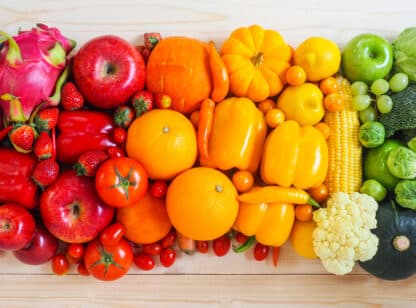When Canada released their updated food guide in January 2019 there was a lot of attention directed towards a few big changes. This latest edition encourages people to eat a variety of unprocessed foods and does away with both serving sizes and food groups entirely. The change that has garnered the most discussion involves dairy, which no longer has a special category devoted to it. Still, I suspect over time a debate over fat may rise to the top.
For those familiar with the U.S. food guide which was last updated from a pyramid to a plate (MyPlate) in 2011, Canada’s new guide will have a familiar feel. Canada’s guide has been retooled from what may have been described as a rainbow into a plate with graphic portion sizes rather than specific serving sizes – a move to encourage more intuitive eating with added phrases like “Take time to eat (with others)” and “Notice when you are hungry and when you are full.”
There are three sections on the plate: ½ devoted to “plenty of fruits and vegetables,” ¼ to protein foods, and the remaining ¼ of the plate to whole grain foods. In order to achieve this new look, two groupings – “meat and alternatives” and “dairy and alternatives” were essentially combined and minimized significantly.
Proponents of the guide praise it for being simple, for removing daily serving amounts, and for being more plant-friendly, an approach that is more in line with dietary guidance from other countries, even recommending to “choose protein foods that come from plants more often.” While many have applauded the removal of a separate dairy category, there is opposition.
Opponents argue these changes will be unfavorable for dairy farmers, and Food and Consumer Products of Canada (FCPC), a trade association representing packaged food and beverage manufacturers across the country, claim the new guide ‘unfairly vilifies’ the entire processed foods category. Having a separate dairy requirement has long seemed unnecessary since valuable nutrients often attributed to dairy, such as calcium, can be found in larger quantities in vegetables.
Perhaps more egregious is their message regarding saturated fats, which we now know are not the culprit in cardiovascular disease, as they continue to be vilified as such and lumped in with processed and sugary foods. For more on this, check out: https://deserthealthnews.com/stories/keep-eating-coconut-oil/.
It will be interesting to see how the U.S. food guide (MyPlate) changes when it is next revised in 2020. Even our understanding of fat has changed significantly since the last release of the U.S. food guide, which still encourages “low-fat or fat-free milk or yogurt” over healthier full fat options. Our understanding of the importance of healthy fats has changed so much in the last decade that there really ought to be a visual section devoted to healthy fat options. It would be nice to see this same understanding that sugars are the primary culprit in atherogenic changes (the formation of fatty plaques in arteries) extended to fruit, as the sugar content in a glass of juice does not make it nutritionally equal to actual fruit. Until then, happy eating!
Dr. Brian Myers is a naturopathic primary care doctor with a focus on gastrointestinal and cardiovascular health at Live Well Clinic in La Quinta. For more information visit www.livewellclinic.org or call (760) 771.5970.
Sources:1) https://food-guide.canada.ca/en; 2) https://www.choosemyplate.gov; 3) https://www.hsph.harvard.edu/nutritionsource/healthy-eating-plate-vs-usda-myplate/











































Comments (0)